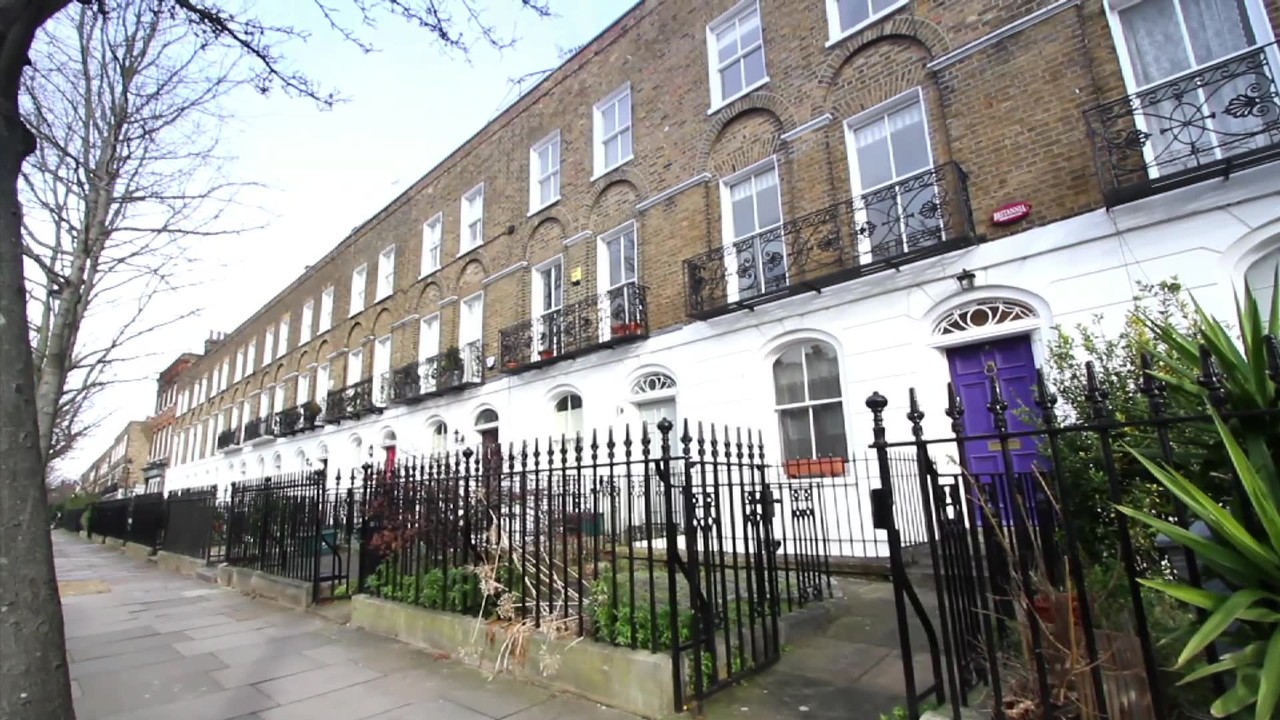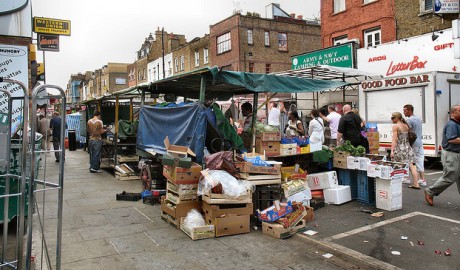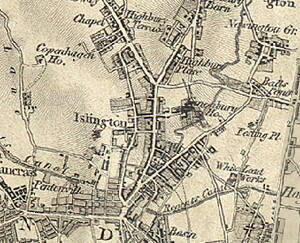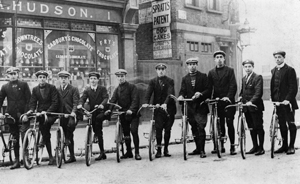
John Emmett was a carpenter and builder and was responsible for building, or organising the building, of more houses in the Cloudesley Estate than any other individual, including No 16 Cloudesley Square (my house - Nick!). An excellent account of this process can be found in Cathy Ross's "Cloudesley: 500 Years in Islington". To summarise, in 1817/18 the Cloudesley Trust let a substantial proportion of what was then the Stonefield Estate to John Emmet and Richard Chapman (the second most prolific builder) to build 114 houses with another 136 planned. Building proceeded on a speculative basis throughout the 1820s and by 1835 the Cloudesley Estate as we know it today was largely complete. John Emmett was almost certainly responsible for other developments in Islington and indeed beyond.
The houses in Cloudesley Square were built in a uniform "New River Style" which features "stuccoed ground floor and round headed windows with the upper floors having square headed windows, but set within an arched recess with a wrought iron balcony" according to a planning application for modifications to No 7 . Another planning application for No 20a adds the following nuggets of information: "yellow and brown stock bricks laid in Flemish bond with simple stucco dressings; roofs obscured by parapet, brick party-wall stacks". These extraordinarily detailed documents are packed with information and are well worth reading in their own right - especially for residents of the Square! The New River Style epithet applies to much of the housing in the Cloudesley Estate and indeed to much of Islington, especially the famous Squares of Islington. The estate agent Chesterton Humberts has a rather excellent description of these squares compiled by its own in-house historian Melanie Backe-Hansen which addresses the architecture of the area's housing in some detail - again, well worth reading.
Of course the question arises as to how an apparently fairly humble carpenter and builder, with, as far as we know, no formal architectural training, was able to create what are today, by common consent, regarded as exemplary, well-proportioned and sought after Georgian townhouses. Buildings which have, moreover stood the test of time and are still by and large a joy to live in today, 200 years later.
John Emmett was born in 1791 in Pentonville to William and Elizabeth Emmett. In 1805 he was apprenticed to William Hancock, a Painter-Stainer, and in 1817 he married Mary Sanders at St Mary’s Islington. From at least 1829 to 1831 he lived in one of his own houses at No 23 Cloudesley Square according to the Poor Rate Books. In the Cloudesley Square censuses for 1851 (see below) and 1861 we find his widow, daughter and son all living at No 1 Cloudesley Square, the father John Emmett himself having died in 1832 aged 41 and buried at St Mary’s. The family was clearly prosperous, given their employment details and given that they shared the house with two servants, one of whom, Eliza Ashdown, was with them for the whole period. It is rather reassuring that the builder's family should live in one of his own houses for such a long time!
| Name | Age | Employment | Relation to Head | Condition | Where Born |
| Mary Emmett | 55 | Annuitant | Head | Widow | Trinity Islington |
| John T(homas) Emmett | 27 | Architect + Proprietor | Son | Unmarried | Trinity Pentonville |
| Mary A Emmett | 24 | Possessor of Houses | Daughter | Unmarried | Trinity Pentonville |
The son John Thomas Emmett was an architect and sufficiently illustrious to be listed in Wikipedia, with examples of his many Victorian Gothic buildings, in London and Scotland. He is described as having a "Puginian" style so perhaps he was inspired in his youth by Holy Trinity Church (built by Charles Barry, who also worked with Pugin on the Houses of Parliament)! Intriguingly, in the 1841 census we find a John Emmett living at No 1 "Emmett's Cottages" in Hornsey Road (was this built by the father or the son?) then in 1847 back at No 6 Cloudesley Square. In 1857 his architectural firm went bankrupt and in 1881 he is a boarder in a house in Hurley, Hampshire, with his occupation listed as "Income from land, 9 houses". But by 1865 he was director of the North London, Highgate and Alexandria Park Railways. In 1891 he has returned to London and is head of a house in Dartmouth Park Hill, "living on his own means", still unmarried but with two servants. He died in Islington in 1898.
Later Addition. Paul Klein, who lives in a house in N19 built by John Thomas Emmett, has kindly sent us the following:
"We live at 10 Cathcart Hill N19. I am researching the history of our street and our house. Our street (before it existed) was part of 47 acres bequeathed in the late 1600s to a church charity that was later known as Corporation of the Sons of the Clergy. In the 1850s three different developers were commissioned to design and build houses and roads. On one side the estate is bounded by portions of Dartmouth Park Hill and Brecknock Road and on the other I think it stretches down to the Holloway Road. One of the developers was John Thomas Emmett, the son of John Emmett, as discussed in your article. John Thomas Emmett designed numbers 2 - 16 Cathcart Hill and numbers 20 - 48 Dartmouth Park Hill, plus others (Wyndham Crescent, I think, without checking). When these roads and houses were going up he was of course in Cloudsley Square.
Emmett's Cottages, Hornsey Road
John Thomas Emmett was born in 1823 and is only 18 years old when living at No.1 Emmett's Cottages, Hornsey Lane as per the 1841 census (shown on the 1864 Stanford map below). Too young, surely, to have built them. John Emmett died in 1833 and leaves property "situate on Hornsey Road". Additionally, there is a Googlebooks reference to "Emmett's-place, Hornsey-road". I think this one can be added to John Emmett's portfolio. Emmett's Cottages are today the site of Montem Primary School (built 1897) located at the junction of Hornsey Road and Seven Sisters Road.

1881 Census, Hampshire
You correctly locate John Thomas Emmett down in Hampshire and must have puzzled over his seemingly remote choice of relocation. Perhaps the answer lies in the fact that he and his sister, Mary Ann, are boarding with a doctor. She would die eighteen days later."


































